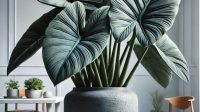
Commonly known as “Elephant Ear” plant, Alocasia is a large collection of houseplants that are known for having bold leaves, with many different types of Alocasias. Houseplant lovers, collectors, and indoor gardeners will love these plants! This guide will help if you are new to Alocasia world or seasoned collector trying to identify your new purchase! With descriptive text and some tips, you will have the ability to identify and appreciate each different species of Alocasia. This article details what they look like, what it takes to care for them, and how to tell them apart from a bold Alocasia Polly to the rare and exotic Alocasia Cuprea.
1. What Makes Alocasia Special?
Alocasia’s unique features are the following:
Foliage: Often large and eye-catching, many have striking vein patterns.
Unique: More than 70 species with distinctive colors, textures, and growth characteristics
Indoor Jungle: Ideal for creating a tropical feel in your home.
Various Alocasia species are great air purifiers.
Due to its versatility and ornamental value, Alocasia is widely one of the most popular genera amongst many plant lovers.
2. Why is it useful to identify alocasia species?
Identifying your Alocasia species helps to make sure that:
- A suitable care according to its own needs.
- A clearer idea of its growing conditions and requirements.
- Greater awareness of its beauty and its limitedness.
You can provide ideal conditions for your plant to flourish in your indoor garden, if you easily identify it.
3. Common Alocasia Species
Alocasia Polly
Dull green leaves with white prominent veins.
Fitment: Size, ideal for tight spots
Care Tip: Prefers low to bright indirect light, but can handle some direct light when grown indoors.
Alocasia Amazonica
Characteristics: Pretty similar to Polly but has slightly longer leaves and more sharper edges.
Parentage: Alocasia longiloba x Alocasia sanderiana
Maintenance Tip: Requires consistent moisture, and well-draining soil.
4. Rare Alocasia Varieties
Alocasia Cuprea
Characteristics: Leaves, dark green, and shiny on the feet
• What makes it special: It’s also known as the “Mirror Plant,” because it shines.
Care Tip: Best grown in a high humidity with stable temperatures.
Alocasia Azlanii
Deep green leaves and colourful purple veins
Rarity — A collector loves when his diamond has the extra sparkle, especially with its colorful, iridescent appearance.
Tip: Naturally, you will want to keep them warm, hydrated, and humid.
5. How To Tell Alocasia Apart According To Its Leaf Shape
Arrowhead Leaves — Found in Alocasia Polly and Amazonica
Roundish Leaves: Alocasia Cuprea (and Alocasia Odora)
Wavy Margin: Alocasia Lauterbachiana and Alocasia Sarian [A. rubra aqua1] especie中国特色特色
6. Alocasia Identify by Leaf Texture
The shiny types: Alocasia Polly and Cuprea would fall under this.
Matte: Alocasia Zebrina has a more toned down appearance.
Metallic: Alocasia Azlanii and Cuprea are iconic for their glossy leaves.
7. Alocasia Size: Small to XXL
Smaller Varieties: Alocasia Polly and Bambino fit into smaller living areas.
Medium Size: Alocasia Amazonica and Lauterbachiana make the best middle choice.
BIG VARIETIES: E.g. Alocasia Macrorrhiza and Odora make a statement in large open spaces.
8. Color Variations in Alocasia
White Veined Green: Alocasia Polly and Amazonica
Azlanii and Cuprea: Alocasia Feels Like Purple or Metal
Variegated: Alocasia Silver Dragon and Hilo Beauty.
9. Alocasia Stem Patterns
Read the full article here – Alocasia Zebrina: Striped Stems (thefountainofwellness.com)
Succulent Stems: In Alocasia Macrorrhiza and Odora.
10. An Introduction to Alocasia Growth Habits
Together Group: Alocasia Polly, Amazonica
Spreading nature: Alocasia Macrorrhiza and Odora are examples of this.
11. Seasonal Changes in Alocasia
Alocasia plants frequently suffer from:
- Winter dormancy: Growth halts, and leaves may drop.
- Spring and Summer Active Growth: See growth and new foliage popping up!
- Seasonal adjustment to care would be necessary to sustain life in the plant.
12. Solutions for Alocasia Issues You May Face
Yellowing Leaves
Reason: Excessive watering, nutrient deficiency, or stress.
Fix: change watering schedule & look for root rot
Brown Tips
Solution: Increase humidity or provide more water.
{ // Solution: Provide more humidity and keep the watering routine the same. }
Drooping Leaves
(A) Cause: Wrong water or light levels.
The solution: Water less and move to somewhere sunnier
13. Guidelines on Alocasia Seedling Condition:
The reasons a young Alocasia plant may have:
- Leaves in smaller and less obvious shapes
- A lighter shade of green than the full-grown plants.
- Keep the temperature and humidity stable for healthy growth.
14. Alocasia Collection: How to Make it Full
For collectors eager to add more to their stash:
- Device Plants Regal Shields: Best recognized for its dark vegetation that is gigantic.
- An excellent choice for medium-light, the Alocasia Hilo Beauty has striking variegated patterns on its leaves.
- Alocasia Silver Dragon: A rare type with silverish leaves.
15. How to Decorate with Alocasia
Alocasia is an extremely ornamental but also a functional plant:
Dark Corners: Lighten using gutsy foliage like Polly or Zebrina.
Mixed Species Groupings: Simply combine and mix for a rich, tropical feel.
Statement Pieces: Draw attention to their beauty with decorative pots.
Conclusion: How Do You Identify an Alocasia?
Public interest in lost Alocasia species are always fascinating with its beauties, from all kinds of leaf features to exotic, outlandish patterns. Whether you know what plant that is correctly determine how much care it needs hence proper attention and it makes you enjoy its beauty even more. Take this guide with you while you browse the many faces of Alocasia, always remembering that for every plant you buy there is no guarantee it will have all of the traits of its parent plant. Happy growing!




